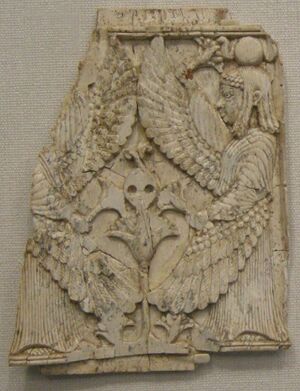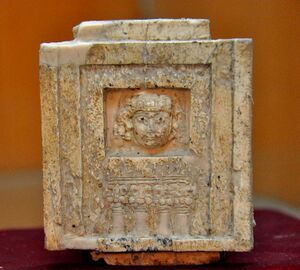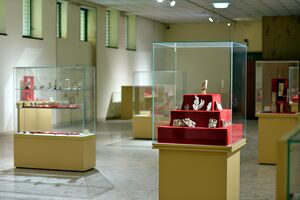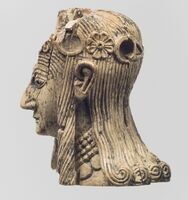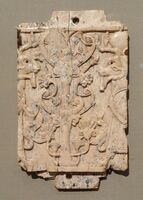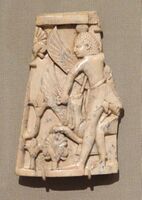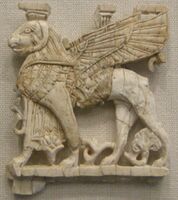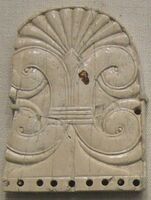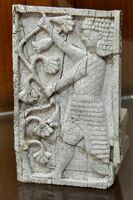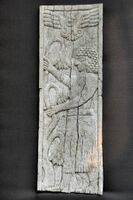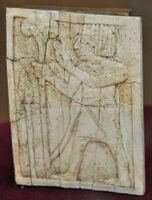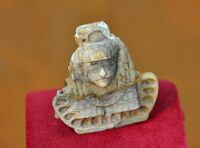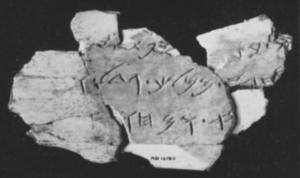عاجيات نمرود
| عاجيات نمرود Nimrud Ivories | |
|---|---|
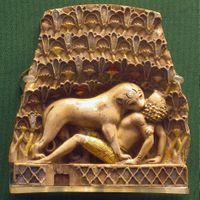 لوح عاجي من نمرود موجود في المتحف البريطاني. اللوح ما زال فيه آثار من التصحيف والطلاء من الذهب. | |
| الخامة | Elephant ivory[1] |
| أنشئت | القرون 9 إلى 7 ق.م. |
| الفترة/الثقافة | الآشورية الجديدة |
| الموقع الحالي | المتحف البريطاني، لندن |
| الهوية | BM 132940 |
عاجيات نمرود Nimrud Ivories هي مجموعة من نحو 6,000 قطعة من العاج المنحوت تعود من القرون 9 إلى 7 ق.م. عُثر عليها في مدينة نمرود الآشورية (في نينوى الحالية في العراق) في سلسلة من التنقيبات البريطانية في القرنين 19 و20. العديد من العاجيات أُخِذت إلى بريطانيا وأودعت في (وإن لم يملكها) المتحف البريطاني. وفي 2011، استحوذ المتحف على معظم العاجيات التي في حوذة بريطانيا عبر تبرعات ومشتريات وسوف تضع المجموعة في العرض. ومن المزمع إعادة باقي القطع إلى العراق. وقد كان هناك عدد كبير من العاجيات بالفعل في حوذة هيئات عراقية متعددة إلا أن العديد منها فـُقِد أو دُمـِّر أثناء الحرب والنهب.
العاجيات معظمها يأتي من خارج بلاد الرافدين ويُعتقد أنها صـُنعت في المشرق ومصر وhave frequently been attributed to the Phoenicians due to a number of the ivories containing Phoenician inscriptions.[2] They are foundational artefacts in the study of Phoenician art, together with the Phoenician metal bowls, which were discovered at the same time but identified as Phoenician a few years earlier. However, both the bowls and the ivories pose a significant challenge as no examples of either – or any other artefacts with equivalent features – have been found in Phoenicia or other major colonies (e.g. Carthage, Malta, Sicily).[3]
Most are fragments of the original forms; there are over 1,000 significant pieces, and many more very small fragments. They are carved with motifs typical of those regions and were used to decorate a variety of high-status objects, including pieces of furniture, chariots and horse-trappings, weapons, and small portable objects of various kinds. Many of the ivories would have originally been decorated with gold leaf or semi-precious stones, which were stripped from them at some point before their final burial. A large group were found in what was apparently a palace storeroom for unused furniture. Many were found at the bottom of wells, having apparently been dumped there when the city was sacked during the poorly-recorded collapse of the Assyrian Empire between 616 BC and 599 BC.[4]

Many of the ivories were taken to the United Kingdom and were deposited in (though not owned by) the British Museum. In 2011, the Museum acquired most of the British-held ivories through a donation and purchase and is to put a selection on view.[5] It is intended that the remainder will be returned to Iraq. A significant number of ivories were already held by Iraqi institutions but many have been lost or damaged through war and looting. Other museums around the world have groups of pieces. وهن منحوتات بأشكال نمطية لتلك المناطق وقد استخدمن لتزيين الأغراض رفيعة المقام من الأثاث ومعدات النقل. العاجيات كن مزينات في الأصل بتصحيف من الذهب والأحجار شبه الكريمة التي اُقتـُلِعت منهن في زمن ما قبل دفنهن الأخير. وقد عـُثر على العديد منهن في قيعان الآبار، إذ يبدو أنهن ألقين فيها أثناء فترة حرب أو اضطرابات.
الوصف
The ivories comprise plaques decorated in relief with intricate carvings of sphinxes, lions, serpents, people, flowers and geometric motifs, as well as carvings of female heads and female figurines. They were carved in various locations across the Ancient Near East, including Egypt, modern Syria and Lebanon, with relatively few carved locally.[6] The ivory used to make these objects would originally have been derived from Syrian elephants which were endemic in the Middle East in ancient times, but by the 8th century BC the Syrian elephant had been hunted close to extinction, and ivory for later objects would have had to be imported from India,[7] or, more likely, Africa.[4]
The ivory plaques are thought to have been used to decorate chariots, furniture and horse trappings, and would originally have been covered in gold leaf or ornamented with semi-precious stones such as lapis lazuli.[8] Some pieces still preserve remnants of gold leafing. Many were already centuries old when put in storage and may have fallen out of fashion by that time. The gold may have been removed from the ivories before they were put in storage,[9] or it may have been taken by the Babylonians when they sacked and razed Nimrud in 612 BC.[8]
Some of the ivories have Phoenician letters engraved on their back, which it is thought may have been used as guides to the assembly of pieces onto the furniture to which the ivories were attached. The presence of Phoenician letters on the ivories suggests that they were the product of Phoenician craftsmen.[10]
In addition to plaques, many small ivory carvings of female heads have been found at Nimrud, most only one or two inches in height, but a few over 5 inches tall. Many of these heads wear a flat cap which is very similar to the flat caps depicted on much earlier ivories from the Tel Megiddo site in modern Israel.[11] Another common carved form found at Nimrud comprises figurines of two naked females joined back to back, which are thought to have been used either as handles for fans or mirrors, or as a decorative element on furniture.[11]
The plaques show a wide variety of themes, some of which exhibit a pure Assyrian style,[7] and some of which show Egyptian influence, with engravings of Egyptian people or gods, and even Egyptian hieroglyphs. However, the Egyptian themes are often misconstrued, and the hieroglyphs do not form valid names, so they would seem to be debased imitations of Egyptian art.[12]
A far greater number of ivories were found at Nimrud than at any other Assyrian site, and it is thought that they had been brought to Nimrud as booty or imported as luxury goods from cities on the Mediterranean coast. Some centuries later it seems that these objects fell out of fashion, and were put into storage.[9]
الاكتشاف
Layard (1845)
العاجيات اُكتشفت في تنقيبات من موقع قصر شلمانصر الثالث (حكم 859–824 ق.م.) في العاصمة الآشورية نمرود. القصر أعاد اكتشافه في 1845 أوستن هنري لايارد، في أول يوم من تنقيباته؛ وفي اليوم الثاني، قام بأول اكتشاف للعاجيات.[13]
Loftus (1854–1855)
More ivories were found during William Kennett Loftus's excavations in 1854–1855. They were found in a group of buildings labelled the "South-East Palace" or "Burnt Palace"; Loftus described the circumstances of the discovery in a letter to the Journal of Sacred Literature in February 1855:
The S.E. Palace at Nimroud has just yielded a large collection of beautiful ivories, relics of a throne or furniture, &c. They have been fitted together by means of rivets, slides, and grooves – a complete Assyrian puzzle, and somewhat dangerous to sit on! Many exhibit traces of gilding and enamel, and were probably broken up for the inlaid gold and jewels with which they were once adorned. There is a decided Egypto-Assyrian character about the whole collection, perfect Egyptian heads being mixed with Assyrian Bulls and Lions. The heads were very fine indeed. Some of the articles were maces, dagger-handles, or portions of chairs and tables (for we have undoubted evidence of the Assyrians using such.) Figures back to back form a shaft, and support a flower-headed capital. There are also boxes, and a vase – all elaborately carved. The Assyrians were adepts in veneering, the layers being highly ornamented with sacred emblems and lion-hunts. Phoenician inscriptions are found on two of three articles. They were found strewed at the bottom of a chamber among wood ashes. They had escaped the flames, but are blackened from lying among smouldering wood. I have got up a horse-load of objects, and am fitting them together as fast as possible, preparatory to boiling them in gelatine. The whole room is not yet explored, as the earth must first be removed from above. I propose going down to-morrow.[14]
Mallowan (1949–1963)
Further discoveries were made between 1949 and 1963 by a team from the British School of Archaeology in Iraq led by the archaeologist Max Mallowan.[8] Mallowan found thousands of ivories, many of which were discovered at the bottom of wells into which they had apparently been thrown when the city was sacked, either in the turmoil that followed the death of Sargon II in 705 BC or when Nineveh fell and was destroyed in 612 BC.[15] Mallowan's wife was the famous British crime novelist, Agatha Christie (1890–1976), who was fascinated with archaeology, and who accompanied her husband on the Nimrud excavations.[16] Christie helped photograph and preserve many of the ivories found during the excavations, explaining in her autobiography that she cleaned the ivories using a fine knitting needle, an orange stick and a pot of face cream.[9]
The collection of ivories uncovered by Mallowan were divided between Iraq and Britain, where they remained at the British School of Archaeology in Iraq (later to become the British Institute for the Study of Iraq) until 1987.[6] They were then put in storage at the British Museum until 2011, but were not put on display.[9] Many of the Iraqi-held ivories have been lost or damaged. Following the Iraq War 2003 the National Museum of Iraq in Baghdad was looted, and many of the ivories kept there were damaged or stolen. Other ivories that were stored in a bank vault in Baghdad were damaged by water when the building was shelled.[9]
In March 2011, the British Museum purchased one third of the Mallowan ivories (comprising 1,000 complete ivories and 5,000 fragments) from the British Institute for the Study of Iraq for £1.17 million, following a public fundraising campaign that raised £750,000 in six months, and with the support of grants from the National Heritage Memorial Fund and the Art Fund.[9][6] This is the second most expensive purchase by the British Museum since the end of the Second World War.[بحاجة لمصدر]
In addition to the purchase, the British Institute for the Study of Iraq has also donated another third of its collection to the British Museum in recognition of the storage of the collection by the museum over the previous 24 years. It is anticipated that the remaining third of the collection will be returned to Iraq sometime in the future.[8][6] A selection of the ivories will be put on display at the British Museum from 14 March 2011.[8]
Oates (1957–1963)
The largest single ivory find was made between 1957 and 1963 when a British School team led by David Oates discovered a room at the Nimrud palace that was dubbed the "ivory room", which had apparently served as the main storage centre for ivory objects amassed by the Assyrian kings. Subsequent excavations by the Iraqi Department of Antiquities unearthed still more ivories.[17]
Other discoveries
In recent years excavations by the Iraqi Department of Antiquities have unearthed more ivories.[17]
Canaanite and Aramaic inscriptions
A number of the ivories contain Canaanite and Aramaic inscriptions – a few contain a number of words, and many more contain single letters. Some of these were found in the mid-nineteenth century by Layard and Loftus (in particular a knob inscribed "property of Milki-ram " [lmlkrm]), and more were found in 1961 by Mallowan and Oates. Of the latter, the most significant finds were excavated in "Fort Shalmaneser" in the southeast of the Nimrud site.[18] Alan Millard published a series of these in 1962; the code "ND" is the standard excavation code for "Nimrud Documents":[18]
- ND 10151 - a 9 cm label with three letters
- ND 10359 - a triangular plaque from a harness, with three letters
- ND 8184 - a curved strip, with six letters, and further smaller fragments
- ND 10150 - the most detailed inscription, on a fragment 9 x 5 cm, with three lines of fragmented text. This is also known as TSSI I 6, having been published in Gibson's Textbook of Syrian Semitic Inscriptions
- ND 10304 - an inscribed griffin, with five letters
- ND 10303 - an inscribed griffin, with three letters
They have been compared to the Arslan Tash ivory inscription and the Ur Box inscription.[18]
One of the fragmentary ivories found at Nimrud carries the name of Hazael. This was probably king Hazael mentioned in the Bible.[19]
Collections
Ivories from Nimrud are held at a number of institutions across the world:
- British Museum, London, England: 6,000 pieces excavated by Mallowan which were formerly held at the British Institute for the Study of Iraq; as well as a number of pieces from other excavations.
- Birmingham Museum and Art Gallery 28 pieces from the British School of Archaeology in Iraq.[20]
- National Museum of Iraq, Baghdad, Iraq.
- The Sulaymaniyah Museum, Iraqi Kurdistan. This museum houses about 30 pieces, which were excavated by Sir Max Mallowan. All of them are contained within 2 large display cases.
- Metropolitan Museum of Art, New York City
- Cleveland Museum of Art
- Erbil Civilization Museum, Iraqi Kurdistan. The museum houses 3 plaques, which were also excavated by Sir Max Mallowan between 1949 and 1963 CE. All of these plaques are on display in Hall 2 of the Museum.
- University of Melbourne, Australia: 3 pieces excavated by Mallowan.[21]
- The California Palace of the Legion of Honor in San Francisco has a group of pieces.[22]
الكتالوجات
The Nimrud Ivories are being published in a series of scholarly catalogues. Many of these are available free online from the British Institute for the Study of Iraq (BISI): links here.
انظر أيضاً
الهامش
- ^ "Nimrud Ivories". British Museum. 2011-02-21. Retrieved 2011-03-15.
- ^ Richard David Barnett. “The Nimrud Ivories and the Art of the Phoenicians” Iraq, vol. 2, no. 2, British Institute for the Study of Iraq, 1935, pp. 179–210, https://doi.org/10.2307/4241579. “The Nationality of the NW. Palace Ivories: That the group of ivories was not Assyrian was concluded on their discovery from their Egyptian appearance. Francois Lenormant, in the Bulletin archéologique de l'Athenaeum français, No. 6, June 1856, asserted that his father, Charles, had been the first to recognize that the pseudo-Egyptian workmanship was in reality Phoenician, whereas Dr. Birch of the British Museum, the ivories' first publisher, had held them for Egyptian work executed in Assyria, or copied there. Posterity, a few dissentients apart, has followed Lenormant, and some wilder misattributions might have been avoided had it been noticed, as stated above, that in Layard's group seven pieces bore a letter of the Phoenician alphabet, and in that of Loftus were two inscriptions apparently also Phoenician. (There seem to be weaker reasons for describing them as Aramaic.) Modern work has only enhanced the plausibility of Lenormant's view. Other ivories of similar type have been found at Samaria, the capital of Ahab, whose connexions with Tyre were notorious. Again, those found at Arslan Tash in North Syria, according to a fragment among them which bore an inscription in what is either Phoenician or Aramaic, were seemingly made and presented by some Phoenician tributaries of Damascus to their overlord. To these points we may add the internal evidence of the religious scenes themselves, which in Part II of this paper are shown to be just such as would be expected in the art of a country so situated as Phoenicia. A concluding point of internal detail, in striking confirmation, is that the loggia windows represented on the panels of the 'Woman at the Window' illustrate what is in the Talmud called 'the Tyrian window', 'through which one can put one's head', i.e. παρακπύτειν, in contrast to the Egyptian type, through which one could not.”
- ^ Martin, S. Rebecca (2017). The Art of Contact: Comparative Approaches to Greek and Phoenician Art. University of Pennsylvania Press, Incorporated. pp. 28, 89. ISBN 978-0-8122-9394-4.
The two greatest challenges of Phoenician art history are thus highlighted by these critical early discoveries: none of the metal bowls and hardly any ivories were found in Phoenicia, and the portable objects that we assign to Phoenician manufacture do not necessarily share stylistic or iconographic features with one another or with material excavated in Phoenicia. Yet it is almost universally believed that these two genres, metal bowls and carved ivories, mark the inception of Phoenician fine art… While it is tempting to ascribe to lack of excavation the problem of discovering the "true" Phoenician origins of worked ivory and metal bowls, the idea is probably fantastical. We have very little direct evidence of metal working or ivory working on the mainland. Published areas of the well-excavated Sarepta (Sarafand, Lebanon) yielded fewer than ten ivory objects, only three of which are figurative, and not even one scrap of a "Phoenician" metal bowl. And, as Hans Niemeyer and others point out, neither bowls nor ivories appear in the main colonies, not at Carthage, Malta, Sicily, or elsewhere. Even Markoe, the foremost expert on "Phoenician" metal bowls, admitted regarding those from Assyria, "we simply do not know where these vessels were produced."
- ^ أ ب Metropolitan note
- ^ British Museum Collection
- ^ أ ب ت ث "Nimrud Ivories". Art Fund. Retrieved 2011-03-08.
- ^ أ ب Frankfort 1970, p. 311
- ^ أ ب ت ث ج "Christie ivories to go on show at British Museum". BBC Online. 8 March 2011. Retrieved 2011-03-08.
- ^ أ ب ت ث ج ح Kennedy, Maev (7 March 2011). "British Museum buys Assyrian treasures cleaned by Agatha Christie". The Guardian. London. Retrieved 2011-03-08.
- ^ Frankfort 1970, pp. 311–312
- ^ أ ب Frankfort 1970, pp. 313–314
- ^ Frankfort 1970, pp. 314–322
- ^ Fant, Clyde E.; Reddish, Michael Glenn (2008). Lost treasures of the Bible: understanding the Bible through archaeological artifacts in world museums. Wm. B. Eerdmans Publishing. p. 113. ISBN 9780802828811.
- ^ Loftus, W.K. The Journal of Sacred Literature (ed. J. Kitto), July 1855, p. 492
- ^ خطأ استشهاد: وسم
<ref>غير صحيح؛ لا نص تم توفيره للمراجع المسماةfant-reddish-2008-113 - ^ "Agatha Christie and archaeology". British Museum. Retrieved 2011-03-08.
- ^ أ ب Fant & Reddish 2008, p. 114
- ^ أ ب ت Millard, A. R. “Alphabetic Inscriptions on Ivories from Nimrud” Iraq, vol. 24, no. 1, 1962, pp. 41–51
- ^ A. R. Millard, Alphabetic Inscriptions on Ivories from Nimrud. Iraq, Vol. 24, No. 1 (Spring, 1962), pp. 41-51 (13 pages). https://doi.org/10.2307/4199711
- ^ Horry, Ruth A (2015). "Conserving Birmingham Museum's Nimrud ivories". Oracc. University of Pennsylvania. Retrieved 19 December 2020.
- ^ "Nimrud Ivories". University of Melbourne. Retrieved 2011-03-20.
- ^ FAMSF press release (see end)
وصلات خارجية
- Short description is different from Wikidata
- Articles with unsourced statements from October 2020
- Archaeological artifacts
- Assyrian art and architecture
- Ivory works of art
- Middle Eastern sculptures in the British Museum
- Nineveh Governorate
- نحت الشرق الأدنى القديم
- نمرود (مدينة)
- Phoenician sculpture
- Archaeological discoveries in Iraq
- لقى أثرية
- الفن والعمارة الآشوريان
- تاريخ العراق
- أعمال فنية من العاج
- مقتنيات من الشرق الأوسط في المتحف البريطاني

